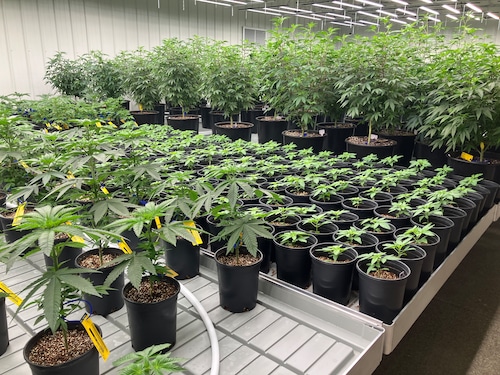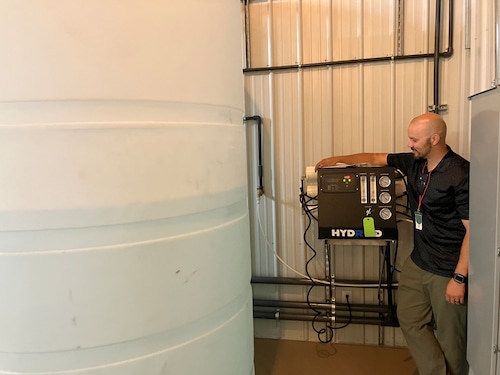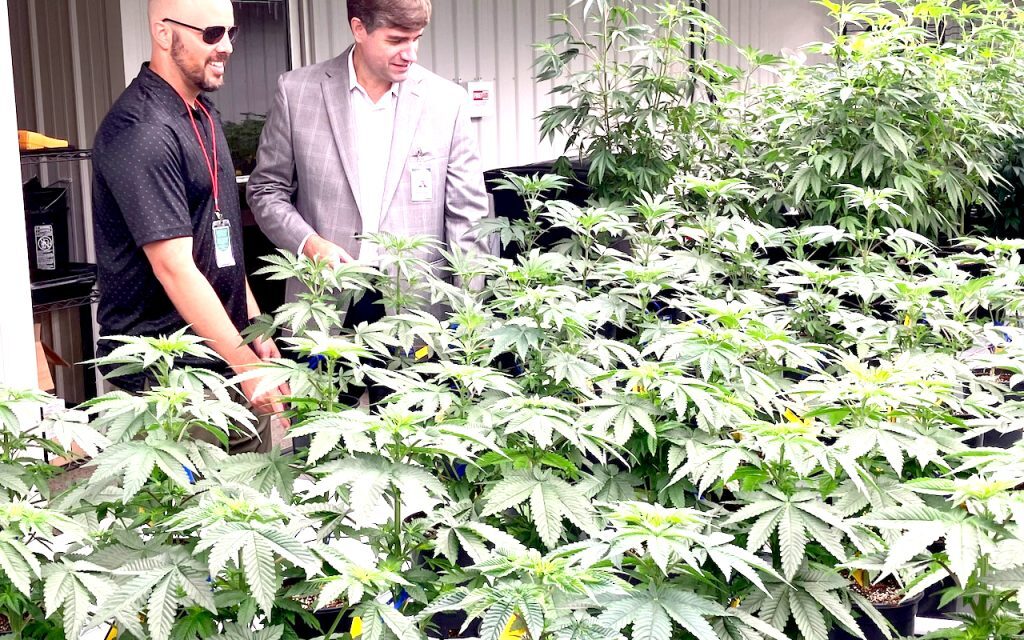By Mike Cason
Some of the first steps in Alabama’s fledgling medical cannabis industry are taking place inside a building behind high security fences, cameras, and warning signs at the CRC of Alabama cultivation facility in the tiny town of Goshen.
About 1,000 marijuana plants – varieties with names like orange cream pop and hella jelly – are now being carefully cultivated at the facility.
Inside the vegetative room – temperature set at 78 degrees and relative humidity 70% – row after row of the two-week to two-month-old green leafy plants are growing in a mixture of coconut husks, coconut pith, and a granular material called perlite.
The scrupulous care and tight security are the most striking takeaways from a tour last week of the CRC of Alabama facility.
While the full launch of Alabama’s medical cannabis industry is snarled in litigation, CRC of Alabama and six other companies have received licenses to grow the plants that will produce gummies, capsules, pills, tinctures, and other products to help patients with chronic pain, the harsh effects of cancer treatment, seizures, muscle spasms, PTSD, depression, panic disorder, and other conditions and symptoms.
“This act, the Compassion Act, was passed for the patients of Alabama in 2021,” said John Reeves, an attorney who oversees security for CRC of Alabama and is the son of one of the owners, Grady Reeves. “We sit here today, still nothing. So, we’re very hopeful that that will come to a resolution in the next few months.”
Licenses for dispensaries, which will sell the products, and for integrated companies, which can cultivate, process, transport, and sell, are still on hold, the result of numerous lawsuits by companies challenging the licensing decisions of the Alabama Medical Cannabis Commission (AMCC).
Controlled access
No passerby could casually wander into the CRC of Alabama cultivation facility or see what is happening inside. A former peanut processing plant, it is surrounded by a high fence posted with signs allowing only authorized entry.
The tight security is mandated by the legislation and regulations passed by the AMCC. There’s a sign-in sheet for visitors. Owners and staff wear identification badges they received after clearing background checks by the Alabama Law Enforcement Agency and FBI, Reeves said.
“Security is going to be a major factor in what we do due to the nature of the industry we’re in,” Reeves said. “We have alarms on all the doors. Only employees have codes to get in, and owners. And then once you are at the facility there are cameras everywhere. There are cameras you can see. There are cameras you can’t see. Everything is 24/7 surveilled, all the time. Every door you walk into or out of, you’re on camera. And we keep that for a number of months on recording.”
“We have people here 24/7 to look after things at night,” Reeves said. “I can be in Troy or wherever I am and pull up my phone, look at the videos on my phone, and see if there’s anything wrong.”

Where the plants grow
CRC of Alabama has three main rooms where the marijuana plants will be raised. The first plants come from seeds. After that, new plants are cloned from existing plants. They spend three weeks in the cloning room.
From there, the plants move to the vegetative room, where they stay about four weeks. After that, they will move to the flowering room, where it will take nine weeks to reach maturity for harvest.
It will be a few weeks before there are plants in the flowering room. On Wednesday, work crews installed lights and other equipment.
The vegetative room, bright and clean, is almost wall-to-wall plants. Large fans keep the air moving. Humidifiers and de-humidifiers activate when needed to keep the humidity at the optimum level. The LED, photo bio lights that are on 18 hours a day are custom made for CRC. In fact, all the equipment is custom made, according to chief operations officer Rob Levy, who has built medical cannabis cultivating facilities in 20 states.
The tables for the plants are on rollers and in sections to allow employees to move freely between the rows while maximizing the production space. Irrigation hoses hang from the ceiling.
Every plant is registered for the AMCC’s tracking system. Employees attach tags to the plants when they reach eight inches tall. Each tag has a bar code and an embedded chip that allows for fast inventory and tracking by a handheld reader, a technology called radio-frequency identification, or RFID.
“From seed-to-sale, we can say that this plant was here,” Reeves said. “This is just for medical cannabis. It can’t be used for any other purpose.”
There are about 15 varieties of cannabis in the vegetative room, with names such as spice, garlic butter, orange cream pop, and hella jelly.
Filters and tanks
The flowering room, next to the vegetative room, does not have any plants yet but has some of the equipment essential for the plants in all three rooms.
Goshen’s municipal water system provides the water, and it goes through a multi-stage filtering process before reaching the plants.

There’s a tank to store about 1,500 gallons of the filtered water, about a two-day supply, Levy said. A dosing computer blends fertilizer with the water to the specifications the plants need in the three rooms. Three 1,000-gallon tanks hold that water.
There’s an automatic transfer switch that Levy called the facility’s most expensive piece of equipment. It provides an interruption-free transfer of power to the facility’s backup generators in the event of a power outage.
Overall, it is a system that is intended to leave as little as possible to chance.
“The thing that people would be most surprised about is the level of redundancy that we have in the system,” Levy said. “In our irrigation system we have tons of redundancy between pumps and backup pumps and tank storage if your facility was to ever go down for whatever reason. Our electrical infrastructure, we have backup generators, automatic transfer switches.
“When you think about all the things that can go wrong, naturally they will. So being prepared for all those things, I think, is the thing that people don’t really talk about when you’re talking about growing plants. You think it’s just a garden and you water it, and it grows. Here there’s a lot more level of infrastructure and redundancy that has to support the growth over a period of time.”
Levy said it takes about 115 days to grow a plant from a clone to a mature, flowering plant, ready to harvest.
After harvest, CRC of Alabama and the other six licensed cultivators can sell the products to one of the four licensed processors, who will make and package the gummies, or gelatinous cubes as the law says, and other products. Levy said he expects gummies to comprise about 50% of the market, more than any other product.
Alabama’s medical cannabis law does not allow the sales of the plant material or smokeable products.
In addition to selling to processors, CRC of Alabama and other cultivators could sell finished and packaged products to dispensaries under contract arrangements with processors.
A key sticking point caused by the litigation is that doctors cannot begin recommending medical cannabis until the AMCC issues licenses for dispensaries. Those are on hold now as part of the court cases.
Montgomery County Circuit Judge James Anderson has a hearing scheduled for Tuesday to help determine the next steps in the complicated litigation. Anderson has said the goal is to allow the industry to get started, but multiple issues have been raised by companies competing for a limited number of licenses allowed by the law. Generally, about two dozen or more lawyers attend the hearings.
Reeves said his father Grady Reeves, has raised cattle and row crops on a farm in Bullock County, near the Pike County line, since the 1970s. Reeves said his father and his business partners saw an opportunity when the Legislature passed the medical cannabis bill three years ago.
“At this point, we’re obviously somewhat disappointed that the litigation is still ongoing,” Reeves said. “But we are very hopeful. There’s been some movement here lately and some more clarity in the way the litigation is going.”
“We feel like in the next few months, we could get a resolution and allow us to get this to the patients that need it,” Reeves said. “That’s the main thing.”











